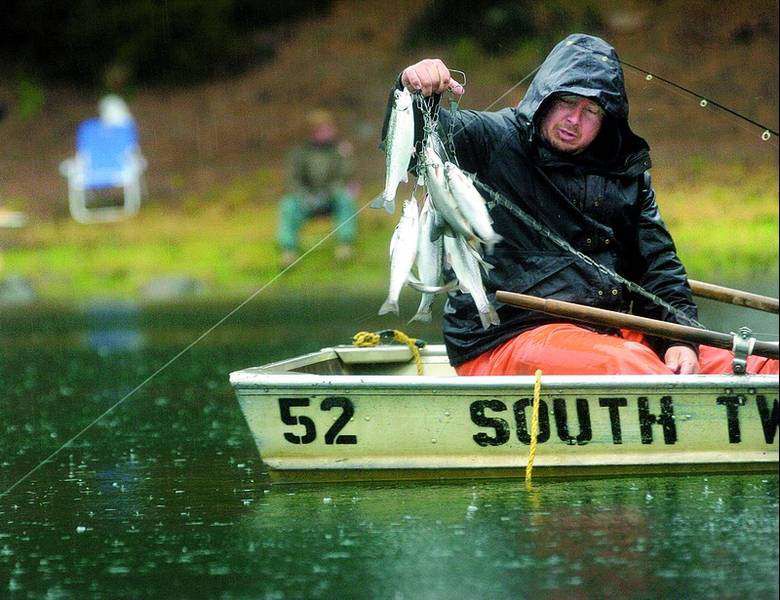Stopping the invasion
Published 4:00 am Thursday, February 15, 2007

- An angler examines his catch on South Twin Lake, a water body that could be treated with the toxin rotenone to kill the brown bullhead in the lake.
Kill ’em all.
That seems to be the only way for biologists to deal with certain illegally introduced species of fish that have invaded several trout fisheries in Central Oregon.
At Diamond Lake in September, the Oregon Department of Fish and Wildlife and other agencies used the toxin rotenone to kill all the invasive tui chub fish, which had damaged the lake’s trout fishery, and the lake is scheduled to be restocked with trout this spring.
The success at Diamond Lake, located in the Cascade Mountains about 100 miles southwest of Bend, has spurred local fisheries biologists to consider the rotenone treatment in certain Central Oregon lakes.
Tops on the list in the area are Walton Lake, in the Ochoco Mountains; Antelope Flat Reservoir, southeast of Prineville; and North and South Twin lakes, west of La Pine. The trout in all four of these lakes are suffering from an invasion of brown bullhead, commonly known as catfish, making for frustrated trout anglers.
Brett Hodgson, a fisheries biologist for the ODFW in Prineville, says that techniques such as electroshocking and gill netting can reduce the number of brown bullhead, but the bullhead will always come back in large numbers if they are not eradicated completely. Hodgson, along with other local biologists, says that poisoning the lakes is the only way to solve the problem.
”Diamond Lake, as successful as it was, opened the door for us to do additional treating of water bodies throughout the state,” Hodgson says. ”If things go well, we might start treating water bodies in 2008.”
Rotenone is derived from a plant root and at a certain concentration is toxic to fish and some insects, according to Steve Denney, the southwest region manager for ODFW. It is not harmful to humans or birds.
Officials dispensed a liquid form of rotenone from boats during the treatment of Diamond Lake last fall.
Hodgson says that bullhead were illegally introduced in Walton Lake in 1993, and in Antelope Flat Reservoir in 2003, possibly by frustrated anglers who wanted another species to catch during drought years when trout angling was unproductive.
In recent years, the bullhead have flourished, while competing with trout for invertebrates such as insects and mollusks and disturbing the water quality by burrowing in the lake bottoms for food, according to Hodgson.
”We don’t anticipate good growth rates or good survival of trout until we get rid of the bullhead,” Hodgson explains. ”They’re an extremely hearty fish. You can go from a small population to a large population in a relatively short period of time: four or five years.”
The ODFW manages for trout in Antelope Flat Reservoir, Walton Lake, and North and South Twin lakes, and not for brown bullhead, which, in large numbers, can cause an overall decline in the health of a fishery.
”Bullhead are not as desired of a fish for most anglers, and their numbers get so high they compete with other fish for food resources,” says Ted Wise, a fisheries biologist for the ODFW in Bend.
Walton Lake, located high in the Ochocos, is a popular fishery that sees plenty of angling pressure. Antelope Flat is more isolated, but Hodgson says that during favorable years anglers have been known to land trout of 20 inches or longer out of the reservoir.
North and South Twin lakes are popular trout fisheries in the summertime, and bullhead have posed a problem in those waters for the last several years, according to Wise. Wise says he has recently altered the trout stocking program in Twin Lakes by stocking larger fish, because fingerlings cannot survive with the bullhead in the water.
Wise adds that North and South Twin are good candidates for the rotenone treatment because there are no inlets or outlets, or other ”areas of concern,” if the lakes were to be chemically treated.
”Unlike some other lakes, they (Twin Lakes) are not nearly as complicated,” Wise says.
More than 10 lakes in Central Oregon are also infested with tui chub, Wise says, including East, Paulina, Big Lava, Little Lava, Davis and Odell lakes, and Crane Prairie Reservoir.
These lakes pose a challenge for chemical treatment, because many of them are relatively large, deep bodies of water, with a variety of fish species.
”It’s always been a matter of, ‘How do we take care of these unauthorized introductions?’ ” Wise says. ”Everything was on hold for quite a few years so we could concentrate on Diamond Lake. We wanted to make sure we had success there, which we did.”
Now, Walton Lake, Antelope Flat Reservoir, and North and South Twin lakes are on ODFW’s rotenone radar. But none of these lakes will be treated until 2008, and most likely not all in the same year, Hodgson says.
”I’d say the conditions are fairly similar in all four of those lakes,” Hodgson notes. ”You have an extremely large population of bullhead, and it’s having a similar impact on the ecosystem and the recreational trout fishery in all of them. We’ll have to sit down and identify which one is the highest priority.”
The ODFW would coordinate with the forest service and nearby resorts before chemically treating the lakes. Fishing on the lakes would be eliminated for several months, before the lakes could be restocked with trout, Wise says. Other recreation activities would also be curtailed for a period of weeks as the rotenone dissipates.
”We’d have to make sure we have enough production in our hatchery setup to go forth and restock them,” Wise says.






